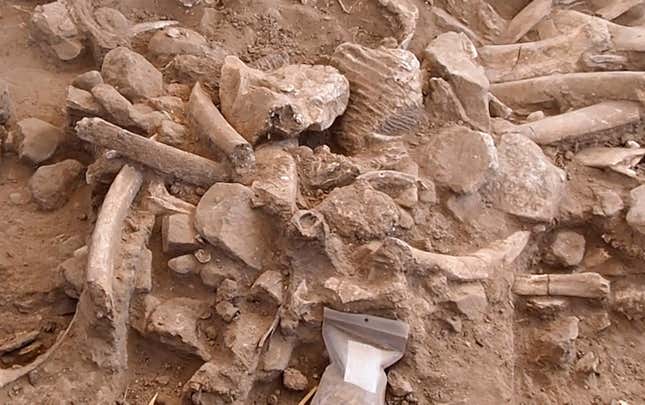
The bones of a mammoth and calf recently uncovered in New Mexico show signs of butchering, an exciting find that could help refine estimates of when humans first populated the Americas.
The specimens date to between 36,250 and 38,900 years ago, according to carbon dating analysis of the bones’ collagen. The paleontological team found blunt-force fractures on the bones. What appear to be flake-knives made from mammoth bones and evidence of a controlled fire were also at the site—signs that humans were involved in the mammoths’ demise. The team’s research appeared last month in Frontiers in Ecology and Evolution.
“It’s not a charismatic site with a beautiful skeleton laid out on its side,” said Timothy Rowe, a paleontologist at The University of Texas at Austin and lead author of the recent paper, in a UT release. “It’s all busted up. But that’s what the story is.”
At first glance, Rowe thought the bone pile looked like a butchering site. But with no complex stone tools nearby—a telltale sign of humankind—he couldn’t be sure.

But running CT scans on several samples from the site revealed 32 bone flakes with noticeable fractures that the team argued could not be explained by geological processes or scavenging. About half of the bone flakes had sharp edges suitable for cutting.
The CT scans also revealed that several of the mammoths’ ribs and vertebrae had punctures, invisible to the naked eye due to how bone-colored sediment filled them in. The team believes these punctures may have been to hasten the draining of grease from the bones.
“There really are only a couple efficient ways to skin a cat, so to speak,” Rowe said in the release. “The butchering patterns are quite characteristic.” (I can only assume that killing and butchering a mammoth required more effort than a cat.)
Besides the mammoth bones, the site also contained evidence of smaller burned animals: birds, rodents, lizards, and fish, despite the fact that the nearest river is 200 feet from the site. The condition of the burned remains indicates they were heated with a controlled fire, rather than flash lightning or other naturally induced fires, according to the researchers.
If all these clues are indeed the remnants of human activity, it would be yet another nail in the coffin for the old Clovis First theory, which held that the first people reached North American around 13,000 years ago. Last year, fossilized human footprints in New Mexico pushed back humankind’s presence in North America by 10,000 years. The newly discovered mammoth site is about 15,000 years older than those footprints. Previous research has suggested that some indigenous Americans in the Amazon are more genetically similar to indigenous Australians and other groups in Oceania than to modern Native American populations, an indicator that multiple populations of humans entered North America from Asia in the ancient past.
More: Footprints Suggest Humans Migrated Deep Into North America Earlier Than Previously Known